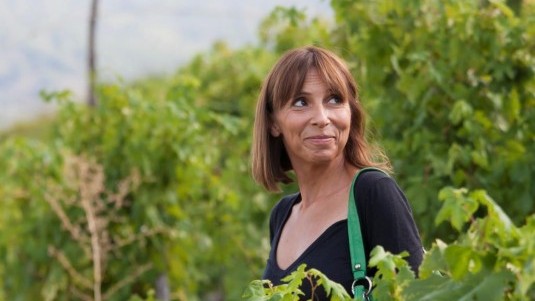Rossese di Dolceacqua Posaù. The Ligurian mountains (1)

“The border is not between Italy and France but involves the whole Mediterranean. There are three great personalities in the Mediterranean: the Gulf of Genoa (Montale), the Gulf of Marseilles (Valéry) and the Gulf of Oran (Camus). They have created a literature that relates to things more than men. Their countries become harsh and emblematic of a human civilization subject to a kind of corrosion of existence, the kind performed by salt. It is a civilization created by light and knowledge, lucidity and corrosion,” Francesco Biamonti wrote some years ago.
A tall and solitary poet, Biamonti was a native of San Biagio della Cima, the heart of the area where Rossese di Dolceacqua is produced, and wrote about the Posaù vineyard in that town in his most celebrated novel, L’Angelo di Avrigue (The Angel of Avrigue), describing it as “distant and abandoned, sitting on a perch at the end of a high and torturous road”.
The area is difficult to imagine for those who only think of the Ligurian coast as something beautiful and rugged. This is a ‘different’ Liguria, one that immediately becomes mountainous and is influenced climate-wise not only by the sea but also neighboring Piedmont. And this is where Rossese di Dolceacqua is produced, in the hinterland of Imperia and a stone’s throw from France. But the border is not between Italy and France, as Biamonti tells us, as much as between the Mediterranean Sea and the austerity of Piedmont.
The wine has a bright but not intense purple color, similar to Grenache, with chiaroscuro aromas and generally light and discontinuous tannins – characteristics that entice many critics to compare it to Burgundy – but it also has an austere, Piedmontese temperament and its spicy, marine and balsamic traits recall wine of the Rhone.
The first wine in Liguria to be given a protected designation of origin (PDO or DOC) classification, Rossese di Dolceacqua has seen a leap in quality over the past decade thanks to improvements made in the winemaking process that eliminated certain reductions typical to the grape.
The size of the vineyards is limited by the fact that they are terraced and the quality of the grapes is enhanced by the vines being alberello-trained. The soil is sandstone with pre-alpine sedimentary rock and having been once under water it has a compacted clay and limestone component.
Giovanna Maccario, together with her husband Goetz Dringenberg, is perhaps the producer who has done the most to draw attention to the area. Today her cru Posaù, Luvaira and Curli (the first and last are practically estate monopoles) are among the area’s most sought after wines by wine lovers. With its grapes from a cold vineyard and in part fermented with the stalks, Luvaira is a dark and austere wine with herbal/balsamic tones that have an exceptional finesse and an amazing floral fragrance. Curli, which Veronelli defined as “Italy’s Romanée-Conti”, has wild aromas and relatively compact tannins. Posaù, on the other hand, is the warmest vineyard and is currently the best known in the appellation. Posaù Biamonti is in the appellation’s richest area, a 2,800 square-meter parcel for the most part planted with over 100-year-old, alberello-trained vines growing in a soil rich in calcite crystals.
This parcel has always been vinified separately but it was not until 2014 that it was bottled as a varietal.
Doctor Wine: Posaù has become a name familiar to wine lovers.
Giovanna Maccario: And we are pleased about this. The area is shaped like of two large amphitheaters and for the most part has a southeast exposure for a total of 15,000 square meters. The vineyards are all terraced with two rows per side running parallel to the walls with a pitch of around 40%. The soil is pebbly and mostly composed of limestone and rich in mica and silica with an ample presence of calcite crystals, above all at the higher altitudes. The altitudes of the vineyards varies from 300 to 360m above sea level, the vines are Provencal alberello-trained, in other words with many branches, and are between 50 and 100 years old. In May, the vines are trimmed to make room for the bunches and allow the vines to benefit from the constant breeze, while fertilization is done using manure pellets. With its southeast exposure there is never any morning dew and the real problem is that of odium, which we combat using powdered sulfur with the addition of powdered copper, except during blossoming. The last treatment is done around July 20.
DW: What is Rossese like to work with in the winery?
GM: I have been doing this for 25 years and I have never thought of creating a wine technically. My wines are made in the most natural way possible using the grapes the vineyard gives me. The only thing I have insisted on, in recent years and when there has been an early September harvest, is to keep the temperature under control during the 5th and 6th days of fermentation, this to keep temperature under 27°C. The wines are made in stainless steel vats to avoid reductions. That’s it.
DW: Glass in hand what is it that distinguishes Rossese di Posaù?
GM: I’d say that the white pepper element always stands out and in the better years dominates over those of red berries. Posaù is one of my warmest vineyards and in some years, like 2011 and 2014, malolactic fermentation does not take place. Sometimes Rossese is like that.
Tomorrow we will conclude our interview with Giovanna Maccario and wind up with a vertical tasting of her Rossese di Dolceacqua Posaù wine

 Italiano
Italiano








